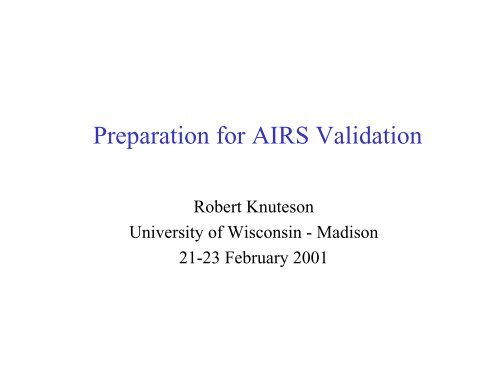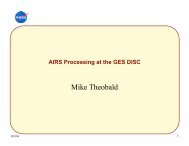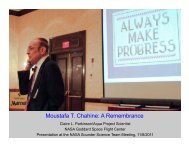Bob Knutsen - AIRS - Nasa
Bob Knutsen - AIRS - Nasa
Bob Knutsen - AIRS - Nasa
You also want an ePaper? Increase the reach of your titles
YUMPU automatically turns print PDFs into web optimized ePapers that Google loves.
Preparation for <strong>AIRS</strong> Validation<br />
Robert Knuteson<br />
University of Wisconsin - Madison<br />
21-23 February 2001
Topics<br />
• MODIS Workshop announcement<br />
• UW <strong>AIRS</strong> Validation Activities<br />
– ARM Best Estimate status<br />
– AFWEX (ARM site validation)<br />
– Land Surface Emissivity<br />
P2
Cloud Mask<br />
• MODIS Cloud Mask Workshop<br />
• May 8-9, 2001 at UW-Madison<br />
hosted by Steve Ackerman<br />
• <strong>AIRS</strong> team representative is invited to<br />
participate<br />
• Focus is on assisting users of the MODIS<br />
cloud mask.<br />
P3
UW <strong>AIRS</strong> Validation Activities<br />
• ARM Temperature & Water Vapor<br />
•Radiance<br />
–ARM<br />
– Aircraft<br />
– MODIS / CERES<br />
• Surface Temperature<br />
– SST<br />
–LST<br />
P4
<strong>AIRS</strong> ARM Atmospheric State Best Estimate<br />
Example Quicklook Image<br />
Best estimate<br />
profiles<br />
• pressure<br />
• temperature<br />
• relative humidity<br />
• water vapor<br />
mixing ratio<br />
P5
<strong>AIRS</strong> ARM Atmospheric State Best Estimate<br />
Example Quicklook Image<br />
air pressure<br />
air temperature<br />
relative humidity<br />
water vapor mixing ratio<br />
integrated column water vapor<br />
P6
Sonde<br />
Temp.<br />
AERI<br />
10 min<br />
Temp.<br />
<strong>AIRS</strong> ARM Atmospheric State Best Estimate<br />
Example Quicklook Image<br />
Overpass<br />
P7
<strong>AIRS</strong> ARM Atmospheric State Best Estimate<br />
Example Quicklook Image<br />
Hourly GOES-8 imagery<br />
around overpass time<br />
P8
<strong>AIRS</strong> ARM Atmospheric State Best Estimate Status<br />
<strong>AIRS</strong> STM, 20-22 Feb 2001<br />
Algorithm Status:<br />
• Fetches required SGP data<br />
• Produces pressure, temperature, and water vapor profiles and their<br />
uncertainties for an input overpass time<br />
• Produces a NetCDF file and quicklook images<br />
• Sample files avaliable from ftp://tyler.ssec.wisc.edu/pub/outgoing/airs/<br />
To Do:<br />
• Produce profiles representative of the AMSU footprint by taking larger scale<br />
spatial gradients within the footprint into account using GOES and model data<br />
• Modify upper level radiosonde water vapor profiles based on sonde/Raman<br />
Lidar comparisons<br />
• Automation<br />
• Test with MODIS TERRA overpasses<br />
• Implement for NSA and TWP site<br />
Dave Tobin, UW-SSEC, 2/19/2000<br />
P9
ARM-FIRE Water Vapor Experiment (AFWEX)<br />
SGP ARM CART Site, November/December 2000<br />
Objectives:<br />
http://arm1.ssec.wisc.edu/~data/exper/afwex/<br />
Use of the DOE Atmospheric Radiation Measurement (ARM) facilities to<br />
assess accuracy limitations of sondes for upper level water vapor<br />
measurements (8-12 km) and calibrate/validate Raman lidar as a key future<br />
satellite validation tool.<br />
• Establish the calibration accuracy of the ARM site RAMAN LIDAR<br />
with LASE and in-situ sensors on the NASA DC8 aircraft.<br />
• Characterization of the absolute accuracy of ARM site radiosondes.<br />
• Measurement of coincident upwelling infrared radiation with the UW<br />
Scanning-HIS, the NPOESS Atmospheric Sounder Testbed (NAST-I and<br />
NAST-M), and the FIRSC.<br />
• Ground-based observations of surface radiative temperature and emissivity.<br />
• Compilation of clear sky validation case studies for forward model and<br />
retrieval studies.<br />
• Observation of thick cirrus and its signature in the far-infrared and millimeter<br />
wave spectral regions<br />
Dave Tobin, UW-SSEC, 2/16/2000<br />
P10
AFWEX Participants<br />
• Ground Based Sensors (ARM SGP Central Facility)<br />
•microwave radiometer, Raman Lidar, GPS, tower and<br />
ground-based in-situ sensors, AERI, … (standard ARM)<br />
• an additional ground-based Raman Lidar (GSFC SRL)<br />
• 3-hourly Vaisala RS-80 radiosondes (ARM)<br />
• a ground-based Differential Absorption Lidar system (MPIDIAL)<br />
• chilled mirror and VIZ radiosondes (NASA WFF)<br />
• DC-8<br />
• zenith and nadir viewing DIAL system<br />
(NASA LaRC LASE)<br />
• in-situ cryogenic dew/frost-point hygrometer<br />
(NASA LaRC CRYO)<br />
• in-situ tunable diode laser water vapor absorption system<br />
(NASA LaRC TDL)<br />
• an infrared spectrometer (UW Scanning-HIS)<br />
• in-situ sensors of CH 4 ,CO,CO 2 ,O 3 , and temperature<br />
(NASA LaRC COAST)<br />
• Proteus<br />
• a high spectral resolution infrared sounder (NAST-I)<br />
• a microwave spectrometer (NAST-M)<br />
• a millimeter-wave/far-infrared spectrometer (FIRSC)<br />
P11
• Typical Flight Plan<br />
• Proteus<br />
• spiral ascent to 41 kft<br />
• mapping pattern at 41 kft<br />
• spiral ascent to 55 kft<br />
• mapping pattern at 55kft<br />
• spiral descent<br />
• Example DC-8 flight track<br />
12/5/2000<br />
AFWEX Operations<br />
•DC-8<br />
• spiral ascent to 41 kft<br />
• level legs at 41, 35, 31, 28, 25kft<br />
• spiral descent<br />
Not to scale<br />
DC-8<br />
4KM GOES WV at 12/5/2000 0315 UTC<br />
P12<br />
55 kft<br />
41 kft<br />
Time →
Flight Summary<br />
• CART Raman Lidar (CRL) and radiosonde time series<br />
CRL depolarization<br />
11/27-12/4<br />
CRL water vapor<br />
(+ upper level from<br />
sondes during the day)<br />
CRL depolarization<br />
12/5-12/9<br />
CRL water vapor<br />
(+ upper level from<br />
sondes during the day)<br />
P13
Example CART Raman Lidar Data, 7-8 Dec 2000<br />
CRL data<br />
30 min integrations<br />
Radiosonde<br />
data<br />
(daytime)<br />
DC-8/Proteus flight Proteus flight<br />
P14
Example Upper Level Water Vapor Intercomparison<br />
Radiosonde/ Raman Lidar/ Raman Lidar/ chilled mirror<br />
sonde/LASE/in-situ hygrometer. AFWEX, 5 Dec. 2000.<br />
Preliminary<br />
P15
LASE (Lidar Atmospheric Sounding Expt) on DC8<br />
Preliminary<br />
P16
280 K<br />
T b<br />
280 K<br />
Scanning HIS Spectra from DC8: 5 level legs<br />
8-13 km, 29 Nov 2000<br />
6.3 μm Water Vapor Band<br />
200 K<br />
1300 Wavenumber (cm -1 ) 1900<br />
T b<br />
15 μm CO 2 Band<br />
600 Wavenumber (cm-1 200 K<br />
) 770<br />
P17
273 K<br />
T b<br />
280 K<br />
6.3 μm Water Vapor Band<br />
263 K<br />
1160 Wavenumber (cm -1 ) 1190<br />
T b<br />
Scanning HIS Spectra from DC8: 5 level legs<br />
8-13 km, 29 Nov 2000<br />
15 μm CO 2 Band<br />
P18<br />
1365 Wavenumber (cm-1 200 K<br />
) 1440
Temperature profiles: radiosondes and derived from opaque CO 2<br />
regions of S-HIS spectra during a spiral descent. 5 Dec 2000<br />
P19
Preliminary ARM Raman Lidar / Radiosonde Comparison<br />
Previous WVIOPs show similar bias.<br />
Turner and Goldsmith, JTECH. 1999.<br />
Preliminary<br />
P20
Effect on OLR; example for a typical AFWEX sonde profile<br />
8-12 km water vapor increased by ~30%; TOA Flux: -0.8 W/m 2<br />
P21
ARM Land Surface Temperature & Emissivity<br />
<strong>AIRS</strong> STM, 20-22 Feb 2001<br />
Objectives:<br />
• Characterize the land surface emissivity characteristics of the DOE ARM site<br />
in order to improve the radiance validation potential of this location.<br />
• Demonstrate the use of MODIS data to characterize subpixel temperature<br />
variations.<br />
• Develop a global dataset of land surface emissivity measurements.<br />
Accomplishments:<br />
• Collaboration with MASTER science team (Simon Hook, et al.)<br />
• PhD Thesis of Nick Bower completed on land surface emissivity measurements.<br />
(Curtin University under Merv Lynch)<br />
• Selected case studies provided to <strong>AIRS</strong> science team.<br />
• ARM site survey conducted during AFWEX (November 2000).<br />
• Investigation of IMG data for use in developing a global dataset.<br />
R. Knuteson, UW-SSEC, 2/19/2000<br />
P22
Quartz<br />
Signal<br />
of pure<br />
Sand<br />
ARM Site Variability: MAS Band 45 - 42<br />
P24
ARM Site Survey 29 Nov. 2000<br />
A survey was conducted to<br />
characterize the land type in<br />
the vicinity of the ARM Southern<br />
Great Plains Central Facility site.<br />
4<br />
6<br />
6<br />
1<br />
16<br />
ARM SGP Central Facility Site:<br />
North-South Survey 29 November 2000<br />
5 4 2<br />
55<br />
Winter Wheat<br />
Pasture (Dry)<br />
BareSoil<br />
Rubble<br />
Soybean (Dry)<br />
MiloSorghum (Dry)<br />
Lowlands<br />
Trees<br />
Buildings<br />
P25
PASTURE<br />
Bare Soil<br />
1.0<br />
0.8<br />
Land Surface Emissivity<br />
Wheat<br />
750 Wavenumber (cm<br />
P26<br />
1250<br />
-1 0.6<br />
)
ARM Land Surface Temperature & Emissivity<br />
<strong>AIRS</strong> STM, 20-22 Feb 2001<br />
MODIS 11μm BT (1 km) 6 September 2000<br />
120 kilometers<br />
R. Knuteson, UW-SSEC, 2/19/2000<br />
To Do:<br />
• Develop a model of land<br />
surfaceemissionbased<br />
upon a survey of land types<br />
and measured emissivities.<br />
•UseMODISdata<br />
to characterize spatial<br />
temperature variations<br />
• Use aircraft SHIS &<br />
NAST-I data from AFWEX<br />
to validate the accuracy of<br />
forward model model<br />
calculations over the<br />
ARM site.<br />
P27
The IMG Instrument<br />
Images from the ERSDAC ADEOS webpage, http://www.eorc.nasda.go.jp/ADEOS/<br />
P28
Global Dataset<br />
P29
1.0<br />
0.3<br />
700 Wavenumber 1300<br />
Regional LSE Characterization<br />
• High spectral resolution permits<br />
relative emissivity spectra<br />
• Arabian Pennisula Case Study<br />
• Mean impact of 10%<br />
• Distribution of emissivities<br />
with range of 30%<br />
• Extensible to other regions.<br />
1<br />
0.7<br />
0.7 1.0<br />
P30
UW <strong>AIRS</strong> Validation Activities<br />
To Do (Pre-launch)<br />
• Create upper level H2O case study from AFWEX<br />
and assist Larrabee Strow in spectroscopic analysis.<br />
• Automate ARM Best Estimate atmospheric profile<br />
product generation and make available to science team.<br />
• Improve land surface characterization of DOE ARM<br />
site for radiance and surface temperature validation.<br />
• Provide science team with a global database of land<br />
surface (relative) emissivity from IMG data.<br />
P31




